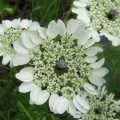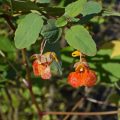- The Miraculous Shiny Bush Plant - January 18, 2021
- Colorful, Edible and Medicinal Celosia - January 10, 2021
- Radish, a Nutritional Power House - December 19, 2020
Tropaeolum majus also known as garden nasturtium, common nasturtium or just nasturtium is a flowering, herbaceous plant with trailing stems that can grow to 1 meter long. It has large, circular leaves with orange to red flowers featuring 3-5 petals. While it is native to South America, the medicinal value of nasturtium, coupled with the beauty of its flowers, have made it a highly sought-after plant worldwide.
[Note: The Right Flowers is not a medical site. Knowledge of and information about the therapeutic benefits and applications of flowers, while known through the ages, does not constitute medical advice. If you are having health issues, you should consult with a physician.]
Basically, nasturtium was introduced to Europe in the 16th century where it was fondly known as Indian cress. The name probably came from the confusion at the time between India and Indies and also due to its flavor which is similar to cress. In the 1800s, a Swedish botanist, Carl Linnaeus, named the genus Tropaeolaceae, meaning trophy.
Nasturtium plants are famous for their bright flowers that have a mild peppery flavor with a mustard tinge. To get the most out of its flowers, use them when they are fresh to make compresses for topical uses or infusions for internal applications. Though nasturtium leaves and its flowers have high medicinal value, the freshness factor is probably one of the reasons why its herbal remedies are less popular compared to other plants.
Medicinal value of nasturtium includes:
Immune boosting
Nasturtium is rich in vitamin C and is often used to prevent and manage common cold and flu. In addition, it has some antibiotic properties. Phenols in the red and orange flowers are great for neutralizing the effect of free radicals, thus protecting the body from chronic diseases including cancer and cardiovascular diseases.
Anti-bacterial, anti-fungal and antiseptic
Nasturtium can be used as a healing agent for treating urinary infections and diseases of the respiratory system. It is an ideal disinfectant for cleaning and managing scrapes and bruises, and an external remedy for treating fungal and bacterial infections.
Skin care
Nasturtium flowers have been used to make ointments for preventing hair loss and treating skin conditions for years. In the absence of the ointment, you can make nasturtium tea or infusion that is equally potent by simmering a mix of the petals and water in a pot for 15 minutes. Strain and store in a cool place or refrigerate.
To encourage hair growth, massage into scalp and rinse after a few minutes. If you want to tone your skin, apply the concoction using a cotton ball and rinse off with warm water. For best results, use daily.
Now that you understand the medicinal value of nasturtium, do you have it brightening your backyard? If not, consider planting it for beauty and health purposes.




